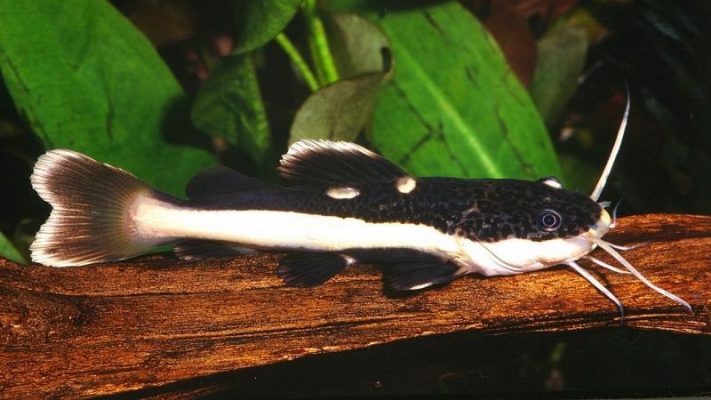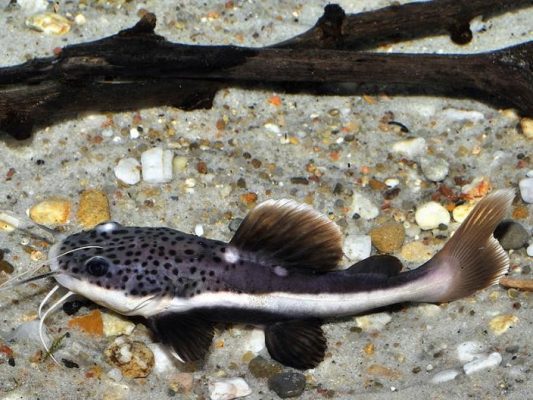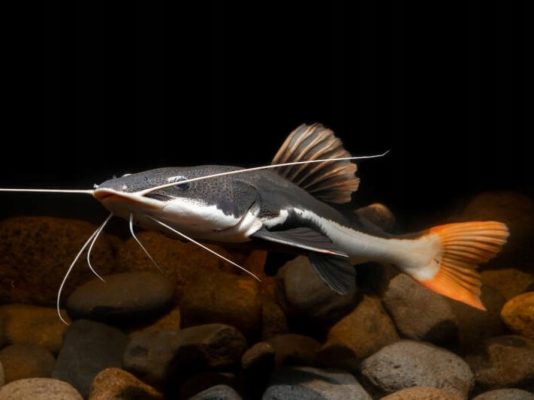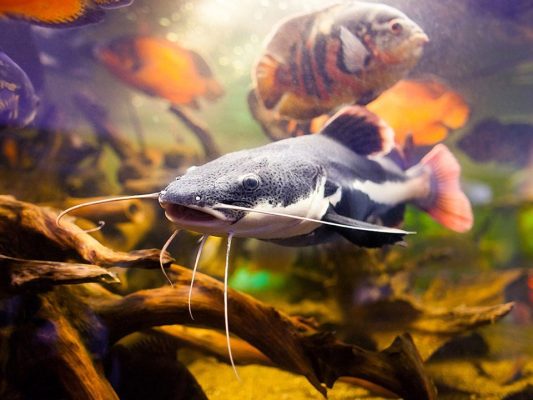Redtail Catfish

Table of Contents
Introduction
The redtail catfish, scientifically known as Phractocephalus hemioliopterus, is a fascinating species that belongs to the family Pimelodidae. Native to the freshwater habitats of South America, particularly the Amazon, Orinoco, and Essequibo river basins, this large and majestic fish has captured the attention of fish enthusiasts and aquarists worldwide.
The redtail catfish holds a significant place in the aquarium fishkeeping community for several reasons. Firstly, its striking appearance, with its elongated body, broad head, and, of course, its namesake red tail, makes it a highly sought-after species among hobbyists. Its large size and impressive growth potential, reaching over 4 feet in length and weighing up to 100 pounds, make it a captivating centerpiece for large aquariums.
Furthermore, the redtail catfish exhibits unique behaviors and characteristics that make it an intriguing addition to any aquarium. Its nocturnal nature, increased activity during the night, and relatively docile behavior during the day provide an interesting dynamic for fishkeepers to observe and appreciate.
This article aims to provide a comprehensive understanding of the redtail catfish, including its physical characteristics, habitat, behavior, diet, reproduction, conservation status, and human interaction.
By exploring its physical characteristics, habitat preferences, behavior patterns, dietary habits, reproductive strategies, conservation status, and its interaction with humans, we can gain a holistic understanding of this remarkable species. Through this comprehensive exploration, we hope to foster greater appreciation for the redtail catfish and promote responsible fishkeeping practices.
By providing detailed information, backed by scientific research and expert insights, this article aims to serve as a valuable resource for both seasoned aquarists and those new to the world of fishkeeping. Let us embark on this journey together and unravel the mysteries of the redtail catfish, uncovering the wonders that lie beneath the surface of its aquatic realm.
Physical Characteristics
The redtail catfish (Phractocephalus hemioliopterus) is a remarkable species known for its impressive size and distinctive features. In this section, we will explore the size and weight range of these magnificent creatures, delve into the details of their physical appearance, and examine any differences between males and females.
Size and Weight Range
Redtail catfish have the potential to grow to astonishing lengths, reaching over 4 feet in captivity and even longer in their natural habitat. It is not uncommon for these giants to weigh up to 100 pounds or more, making them one of the largest freshwater fish species in the world. Their immense size is a testament to their adaptability and evolutionary success.
Distinctive Red Tail and Other Physical Features
As their name suggests, redtail catfish are easily identifiable by their vibrant red tail. This striking feature sets them apart from other catfish species and adds to their allure in the aquarium trade. However, their physical characteristics extend beyond their magnificent tails.
Redtail catfish have an elongated body with a sleek and streamlined shape, allowing them to navigate swiftly through the water. Their broad head houses a large mouth, equipped with sharp teeth that aid in capturing and consuming their prey. This combination of attributes makes them formidable predators in their natural habitat.
Sexual Dimorphism
When it comes to size and appearance, there are noticeable differences between male and female redtail catfish. Males tend to be larger than females, both in terms of length and overall body size. Additionally, males may exhibit more vibrant coloration, particularly during the breeding season, as they compete for the attention of females.
While sexual dimorphism is not as pronounced in redtail catfish compared to some other fish species, careful observation and comparison can reveal subtle variations in size and appearance between the sexes. Understanding these differences contributes to our knowledge of their biology and behavior.
To further explore the physical characteristics of redtail catfish, researchers have conducted numerous studies and collected valuable data. For instance, a study published in the Journal of Fish Biology found that the average length of redtail catfish in the wild is around 2.5 feet, with females generally being slightly smaller than males. These findings support the notion that sexual dimorphism exists in this species.
In addition to scientific research, the experiences and observations of aquarium enthusiasts and fishkeepers provide valuable insights into the physical characteristics of redtail catfish. Many hobbyists have marveled at the growth potential of these fish, witnessing firsthand their remarkable ability to reach impressive sizes when provided with suitable conditions and care.
In conclusion, the physical characteristics of redtail catfish are truly awe-inspiring. From their potential to grow over 4 feet in length and weigh up to 100 pounds, to their distinctive red tail, elongated body, broad head, and large mouth, these fish captivate the imagination of both researchers and fish enthusiasts alike. Understanding the differences between males and females adds another layer of intrigue to their biology. As we continue to explore and appreciate the wonders of the natural world, the redtail catfish stands as a testament to the incredible diversity and beauty found within our aquatic ecosystems.
Habitat
The redtail catfish, scientifically known as Phractocephalus hemioliopterus, is a native species of South America primarily found in the Amazon, Orinoco, and Essequibo river basins. These river systems provide the ideal habitat for the redtail catfish, allowing it to thrive in its natural environment.
In its preferred habitats, which include rivers, lakes, and flooded forests, the redtail catfish exhibits specific behaviors and feeding habits that are influenced by its surroundings. The species is well-adapted to these diverse habitats, allowing it to survive and flourish in various conditions.
One of the most remarkable adaptations of the redtail catfish is its ability to breathe air using a specialized labyrinth organ. This organ enables the catfish to extract oxygen from the atmosphere, supplementing its gill respiration. This adaptation is particularly advantageous in habitats with low oxygen levels, such as stagnant or shallow waters.
The redtail catfish is also known to inhabit areas with dense vegetation, such as flooded forests. These areas provide ample cover and food sources for the species as they are home to a wide variety of aquatic plants, insects, and small fish. The catfish utilizes its elongated body and broad head to navigate through these vegetated habitats, allowing it to hunt and explore with ease.
Furthermore, the redtail catfish is known to be a highly adaptable species, capable of surviving in both clear and murky waters. This adaptability allows it to exploit a wide range of habitats, ensuring its survival even in changing environmental conditions.
Research has shown that the redtail catfish exhibits a preference for slow-moving or still waters as they provide a more stable environment for feeding and breeding. However, they are also capable of venturing into faster-flowing rivers and lakes when necessary, displaying their versatility as a species.
The influence of habitat on the behavior and feeding habits of the redtail catfish is evident. In rivers and lakes, where the current is stronger, the catfish may exhibit more active and aggressive feeding behavior, taking advantage of the increased flow to capture prey. On the other hand, in flooded forests and stagnant waters, the catfish may adopt a more patient and stealthy approach, relying on camouflage and ambush tactics to secure its meals.
Overall, the redtail catfish’s habitat plays a crucial role in shaping its behavior, feeding habits, and overall survival. Its ability to adapt to various environments, coupled with its unique adaptations, allows it to thrive in the diverse ecosystems of South America. However, it is important to note that the destruction of natural habitats, pollution, and overfishing pose significant threats to the redtail catfish population. Conservation efforts and responsible fishkeeping practices are essential to ensure the long-term survival of this remarkable species.
Behavior
Nocturnal Nature of Redtail Catfish
The redtail catfish, Phractocephalus hemioliopterus, is predominantly nocturnal, exhibiting increased activity during the night and relatively docile behavior during the day. This behavioral adaptation allows them to avoid predators and take advantage of the cover of darkness to hunt for food.
Research has shown that redtail catfish have specialized sensory organs, such as electroreceptors, which enable them to detect prey in low-light conditions. These electroreceptors are located on their skin and help them navigate and locate potential food sources, even in murky waters. This heightened sensory perception during the night contributes to their successful hunting strategies.
Social Behavior and Hierarchy Within a Group
Redtail catfish are known to exhibit social behavior and establish a hierarchical structure within their groups. They are often found in small schools or shoals, consisting of individuals of various sizes. Observations have revealed that larger individuals tend to dominate smaller ones, establishing a clear pecking order.
Territoriality and aggression have also been observed in redtail catfish. They may display aggressive behaviors, such as fin flaring and body posturing, to establish dominance or defend their territory. These territorial disputes are most commonly observed during the breeding season or when resources, such as food or shelter, are limited.
Hunting and Feeding Behavior
The redtail catfish is a formidable predator, known for its predatory nature and ability to swallow large prey whole. Their elongated body, broad head, and large mouth equipped with sharp teeth make them efficient hunters. They are opportunistic feeders, preying on a variety of smaller fish, crustaceans, and insects.
When hunting, redtail catfish employ a sit-and-wait strategy, patiently lurking in ambush positions near potential prey. Once a suitable target is detected, they rapidly strike, engulfing the prey in their cavernous mouth. Their ability to swallow prey whole allows them to consume relatively large meals, contributing to their rapid growth and impressive size.
Migration Patterns and Impact on Behavior and Distribution
While redtail catfish are primarily sedentary, some evidence suggests that they may exhibit limited migration patterns. These migrations are often associated with changes in water levels or seasonal variations in food availability. During these movements, redtail catfish may travel upstream or downstream in search of more favorable conditions.
Migration patterns can have a significant impact on the behavior and distribution of redtail catfish populations. For instance, when water levels rise during the rainy season, redtail catfish may move into flooded areas to take advantage of new feeding opportunities. Conversely, during dry periods, they may retreat to deeper pools or areas with more stable water conditions.
Understanding the migration patterns of redtail catfish is crucial for their conservation and management. It provides valuable insights into their habitat requirements and helps identify critical areas for protection. Additionally, studying the impact of migration on their behavior and distribution can contribute to effective conservation strategies and the sustainable management of their populations.
In conclusion, the redtail catfish exhibits fascinating behavior that is shaped by its nocturnal nature, social interactions, hunting strategies, and potential migration patterns. By delving into the intricacies of their behavior, we gain a deeper understanding of this species and its ecological role. Such knowledge is vital for the conservation and responsible management of redtail catfish populations, ensuring their long-term survival in both their natural habitats and the aquarium trade.
Diet
Overview of the redtail catfish’s diet in the wild, emphasizing its role as an opportunistic feeder
The redtail catfish, Phractocephalus hemioliopterus, is a highly adaptable species known for its opportunistic feeding behavior. In the wild, these catfish have a diverse diet that allows them to exploit a wide range of food sources. This flexibility in feeding habits is crucial for their survival, as it enables them to thrive in various aquatic environments.
Prey items commonly consumed, such as smaller fish, crustaceans, and insects, and their nutritional value
Redtail catfish are voracious predators and have a broad range of prey items in their diet. They primarily feed on smaller fish, including tetras, cichlids, and characins. These fish provide essential nutrients such as proteins, fats, and minerals, which are vital for the redtail catfish’s growth and overall health.
In addition to fish, redtail catfish also consume a variety of crustaceans, such as crabs and shrimp. These crustaceans are rich in calcium and other minerals, contributing to the catfish’s skeletal development and maintaining its physiological balance.
Furthermore, redtail catfish supplement their diet with insects, including beetles, dragonflies, and grasshoppers. These insects offer a valuable source of protein and are often found near the water’s surface, making them easily accessible to the catfish.
Feeding habits and techniques employed by redtail catfish, including their ability to detect and capture prey using sensory adaptations
Redtail catfish possess remarkable sensory adaptations that aid in their ability to detect and capture prey. One of their most notable adaptations is their acute sense of smell. They have highly developed olfactory organs, allowing them to detect the scent of potential prey from a considerable distance.
Once a potential prey item is detected, redtail catfish employ their excellent vision to track and pursue it. Their eyes are positioned on the sides of their head, providing them with a wide field of view. This visual acuity enables them to accurately assess the distance and speed of their prey, facilitating successful hunting.
When it comes to capturing prey, redtail catfish utilize their powerful jaws and large mouth. They are capable of engulfing relatively large prey whole, thanks to their expandable stomachs. This unique feeding behavior allows them to consume prey that may be larger than their own body size.
Additionally, redtail catfish possess a specialized sensory organ called the lateral line system. This system consists of a series of sensory cells that detect changes in water pressure and vibrations. It helps the catfish locate prey, especially in low-light conditions or murky waters.
In summary, the redtail catfish’s diet is diverse and opportunistic, encompassing smaller fish, crustaceans, and insects. Their feeding habits, combined with their sensory adaptations, enable them to efficiently detect, track, and capture prey. This adaptability in their diet and feeding behavior is essential for their survival in their natural habitat.
Reproduction
Mating behavior and courtship rituals observed in redtail catfish, including any displays or behaviors associated with breeding
The redtail catfish exhibits fascinating mating behavior and courtship rituals that are essential for successful reproduction. During the breeding season, which typically occurs in their natural habitat during the rainy season, male redtail catfish engage in elaborate displays to attract females. These displays involve vigorous swimming patterns, fin flaring, and body contortions, serving as visual signals to communicate their readiness to mate.
In addition to visual displays, male redtail catfish also produce low-frequency sounds known as “grunts” during courtship. These grunts play a role in attracting females and establishing dominance among competing males. The intensity and frequency of these grunts vary depending on the male’s size and reproductive condition, with larger males producing more pronounced and frequent vocalizations.
Description of the spawning process, highlighting the role of male and female individuals in fertilization
Once courtship is successful, the female redtail catfish carefully selects a location, often submerged vegetation or crevices within their habitat, to lay her eggs. The male then fertilizes the eggs externally by releasing his sperm over them. This external fertilization method is common among many fish species, including the redtail catfish.
The female redtail catfish can lay a large number of eggs, typically ranging from a few hundred to several thousand, depending on her size and reproductive condition. The eggs are small and adhesive, allowing them to stick to the chosen substrate. This adhesive nature helps protect the eggs from being swept away by water currents and provides a safe environment for their development.
Gestation period and number of offspring produced, discussing any variations or factors that may influence reproductive success
After fertilization, the redtail catfish eggs undergo a relatively short gestation period, lasting around 3 to 5 days. The exact duration of the gestation period can vary depending on environmental factors such as water temperature and oxygen levels.
The number of offspring produced by female redtail catfish can vary significantly. Factors such as the female’s size, age, and overall health can influence the number of eggs she produces. Larger females tend to produce a greater number of eggs compared to smaller individuals. Additionally, environmental conditions, such as the availability of food and suitable spawning sites, can also impact the reproductive success of redtail catfish populations.
Parental care, if any, provided by redtail catfish, including the protection of eggs or fry
Redtail catfish do not exhibit significant parental care beyond the initial act of fertilization. Once the eggs are laid and fertilized, both male and female redtail catfish abandon the nest, leaving the eggs to develop and hatch on their own. This lack of parental care is common among many fish species, as their reproductive strategy relies on producing a large number of offspring, increasing the chances of survival for at least some of the offspring.
However, it’s worth noting that the adhesive nature of the redtail catfish eggs provides some level of protection against predation and environmental factors. The sticky eggs adhere to the substrate, reducing the risk of being swept away by water currents or consumed by opportunistic predators. This natural adaptation enhances the chances of successful hatching and survival for the next generation of redtail catfish.
In conclusion, the redtail catfish exhibits fascinating reproductive behaviors and adaptations that contribute to its successful reproduction. From elaborate courtship rituals to external fertilization and adhesive eggs, these fish have evolved strategies to ensure the survival of their offspring. While they do not provide significant parental care, their reproductive success is influenced by various factors, such as the number of eggs produced and environmental conditions. Understanding these aspects of redtail catfish reproduction is crucial for their conservation and the responsible management of their populations.
Conclusion
In conclusion, this article has provided a comprehensive understanding of the redtail catfish (Phractocephalus hemioliopterus), covering its physical characteristics, habitat, behavior, diet, reproduction, conservation status, and human interaction. By summarizing the key points discussed throughout the article, we can gain a deeper appreciation for this remarkable species and recognize the importance of its conservation.
The redtail catfish is a fascinating creature with remarkable physical characteristics. It can grow over 4 feet in length and weigh up to 100 pounds, making it one of the largest freshwater fish species. Its distinctive red tail, elongated body, broad head, and large mouth make it easily recognizable. Additionally, there may be sexual dimorphism observed in the species, with differences in size and appearance between males and females.
Understanding the redtail catfish’s habitat is crucial for appreciating its behavior and ecological role. This species is naturally distributed in South America, particularly in the Amazon, Orinoco, and Essequibo river basins. It prefers habitats such as rivers, lakes, and flooded forests, which influence its behavior and feeding habits. The redtail catfish has also adapted to its environment by developing a specialized labyrinth organ, allowing it to breathe air.
The redtail catfish’s diet is opportunistic, consuming smaller fish, crustaceans, and insects in the wild. These prey items provide essential nutrients for its survival. The species employs various feeding habits and techniques, utilizing sensory adaptations to detect and capture prey effectively.
Reproduction in redtail catfish involves mating behavior, courtship rituals, and the spawning process. Both male and female individuals play a role in fertilization, with variations in the gestation period and the number of offspring produced. While parental care may be limited, some individuals may protect their eggs or fry.
The conservation status of redtail catfish is of concern. Habitat destruction, pollution, overfishing, and the aquarium trade pose significant threats to its survival. Efforts have been made to protect and conserve redtail catfish populations, including the establishment of protected areas and conservation programs. Legislation and international agreements play a vital role in conservation, with regulations and initiatives aimed at preserving the species.
Human interaction with the redtail catfish is predominantly through the aquarium trade. It is a popular species among fishkeepers due to its appeal and availability in the market. However, keeping redtail catfish as pets presents challenges and considerations, such as the need for large tanks, suitable tank mates, and specialized care. It is crucial to address the potential ecological impacts of releasing redtail catfish into non-native habitats, emphasizing the risks of invasive species and the importance of responsible fishkeeping practices.
In conclusion, the redtail catfish is an extraordinary species that deserves our understanding and conservation efforts. By appreciating its physical characteristics, habitat, behavior, diet, reproduction, conservation status, and human interaction, we can contribute to its long-term survival. Continued research, conservation efforts, and responsible fishkeeping practices are essential for the future prospects of the redtail catfish population. Let us strive to protect this remarkable species and ensure its presence in both its natural habitat and the aquarium trade for generations to come.



